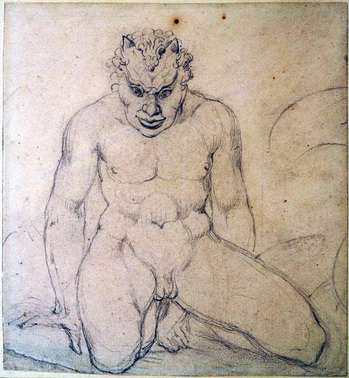William Blake (1757-1827), A Squatted Devil with Young Horns, ca. 1810. Pencil on paper. Butlin no. 596. Robert H. Taylor art collection.
This pencil drawing by William Blake was never published and in fact, it hasn’t yet been identified as a study for any particular book or print or painting. Blake wrote about many devils but the word satyr does not appear in any of Blake’s poetry (which we can check thanks to the searchable Blake archive at the University of Virginia).
However, Blake did engrave two satyrs in the print he made after William Hogarth’s painting Beggar’s Opera. In Hogarth’s design the stage is framed with a crouching satyr on either side and according to the Tate records, the original frame also had two satyrs carved into the sides.
Princeton’s drawing is mentioned twice in Blake literature. Butlin writes, “The title is taken from Rossetti, who continues, ‘The face is somewhat of the Satyr type. Ordinarily good.’ Certainly, a satyr rather than a devil seems to be intended in this fairly highly finished figure. The background is slightly indicated to suggest rocks.” (Martin Butlin, The Paintings and Drawings of William Blake (EX N6797.B57B87Q)).
William Rossetti is quoted from p. 251 in Alexander Gilchrist (1828-1861), Life of William Blake, “Pictor ignotus”. With selections from his poems and other writings … (London, Cambridge: Macmillan and Co., 1863). Rare Books (Ex) 3631.3.692.
